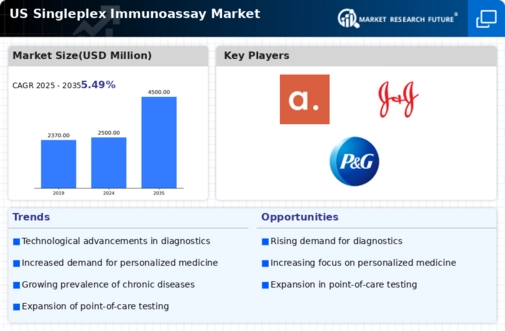Expansion of Clinical Applications
The expansion of clinical applications for singleplex immunoassays is driving market growth. These assays are increasingly being utilized in various fields, including oncology, cardiology, and infectious disease diagnostics. The ability to detect specific biomarkers with high accuracy makes singleplex immunoassays valuable tools for disease diagnosis and monitoring. As healthcare providers seek to implement more targeted therapies, the demand for precise diagnostic tools is likely to rise. Furthermore, the integration of singleplex immunoassays into clinical workflows is becoming more common, as they offer rapid results that can inform treatment decisions. This trend suggests a promising future for the singleplex immunoassay market as it adapts to the evolving needs of healthcare.
Rising Demand for Point-of-Care Testing
The increasing demand for point-of-care testing is a notable driver in the singleplex immunoassay market. Healthcare providers are seeking rapid diagnostic solutions that can be performed at the site of patient care, reducing the need for centralized laboratory testing. This trend is particularly evident in emergency departments and outpatient settings, where timely results are crucial for effective patient management. The market for point-of-care testing is projected to grow at a CAGR of approximately 10% over the next few years, indicating a robust shift towards decentralized testing. As a result, manufacturers of singleplex immunoassays are focusing on developing user-friendly, portable devices that can deliver accurate results quickly, thereby enhancing their market presence and meeting the evolving needs of healthcare professionals.
Growing Investment in Research and Development
The growing investment in research and development (R&D) is a critical driver for the singleplex immunoassay market. As the demand for innovative diagnostic solutions rises, companies are allocating substantial resources to develop new assays that can address unmet clinical needs. This trend is particularly evident in the fields of oncology, infectious diseases, and autoimmune disorders, where precise and rapid diagnostics are essential. According to recent estimates, R&D spending in the diagnostics sector is expected to increase by approximately 15% annually, reflecting the industry's commitment to advancing diagnostic capabilities. This influx of investment not only fosters innovation but also enhances the competitive landscape of the singleplex immunoassay market.
Technological Innovations in Assay Development
Technological innovations in assay development are significantly influencing the singleplex immunoassay market. Advances in microfluidics, nanotechnology, and automation are enhancing the sensitivity and specificity of these assays, making them more appealing to laboratories and healthcare providers. For instance, the introduction of high-throughput screening methods allows for the simultaneous analysis of multiple samples, thereby increasing efficiency. Furthermore, the integration of artificial intelligence in data analysis is streamlining the interpretation of results, which is crucial for clinical decision-making. As these technologies continue to evolve, they are likely to expand the applications of singleplex immunoassays, thereby driving market growth and attracting investment from various stakeholders.
Increased Focus on Disease Prevention and Management
The heightened emphasis on disease prevention and management is driving growth in the singleplex immunoassay market. With a growing awareness of chronic diseases and the importance of early detection, healthcare systems are increasingly adopting diagnostic tools that facilitate proactive health management. Singleplex immunoassays offer a reliable method for detecting specific biomarkers associated with various conditions, enabling clinicians to make informed decisions. The market is expected to witness a surge in demand as healthcare providers integrate these assays into routine screenings and preventive health programs. This shift not only enhances patient outcomes but also aligns with broader public health initiatives aimed at reducing healthcare costs associated with late-stage disease treatment.

















Leave a Comment